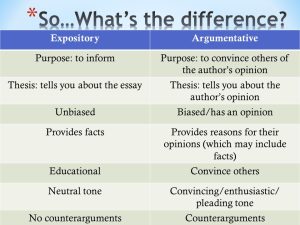Chapter 13: Expository (Informative) Essays
What is an expository essay?
An expository or informative essay is one that explains a writer’s ideas by defining, explaining, informing, or elaborating on points to allow the reader to clearly understand the concept or topic. Expository essays seek to inform and educate a reader on a particular topic while still including your own insights, ideas, and conclusions on the issue.
Many of your future academic workplace writing assignments will be expository–explaining your ideas or the significance of a concept or action. An expository essay allows the writer the opportunity to explain his or her ideas about a topic and to provide clarity for the reader by using:
- Facts
- Explanations
- Details
- Definitions
It may also include the writer outlining steps of a procedure in a way that is straightforward for the reader to follow. It is purely informative and often contains elements of summary.

Imagine you need to verbally explain a concept to your classmates, maybe a behavioural theory. What are the key elements on which you would focus? How would you organize the information? You could explain who came up with the theory, the specific area of study to which it is related, its purpose, and the significant details to explain the theory. Telling these four elements to your classmates would give them a complete, yet summarized, picture of the theory, so they could apply the theory in future discussions.
Although you did this verbally, you were still fulfilling the elements of an expository essay by providing definition, details, explanations, and maybe even facts if you have a really good memory. This is the same process that you would use when you write an expository essay. You may actually be doing this all the time; for example, when you are giving someone directions to a place or explaining how to cook something. In the following sections of the chapter, you will practise doing this more in different expository written forms.
The Structure of an Expository Essay
Sections versus Paragraphs
You will recall from the chapter on academic paragraphs that the 5-paragraph model is not the only way to write an essay. Instead, you should instead think of your essay in terms of sections (there may be five, but if so, that’s coincidence, not a rule), and each section may have multiple paragraphs.
To understand further why you need to think beyond the five-paragraph essay, imagine you have been asked to submit a six-page paper (approximately 1,500 words). If you were to only use five paragraphs, that paper is going to be a long, jumbled mess. If your paragraphs are too long, they likely have too many ideas and your reader may become confused.
Instead, if you think of your essays being divided into sections (with possibly more than one paragraph per section), your writing will likely be more organized and allow your reader to follow your presentation of ideas without creating too much distance between your paragraph’s supporting points and its topic sentence.
Consider Your Audience: How Much Do They Know?
Later in this chapter, you will work on determining and adapting to your audience when writing, but with an expository essay, since you are defining or informing your audience on a certain topic, you need to evaluate how much your audience knows about that topic (aside from having general common knowledge). You want to make sure you are giving thorough, comprehensive, and clear explanations on the topic. Never assume the reader knows everything about your topic (even if it is covered in the reader’s field of study). For example, even though some of your instructors may teach criminology, they may have specialized in different areas from the one about which you are writing; they most likely have a strong understanding of the concepts but may not recall all the small details on the topic. If your instructor specialized in crime mapping and data analysis for example, he or she may not have a strong recollection of specific criminology theories related to other areas of study.
However, you also want to be mindful that you are not underestimating your reader and providing information that could be seen as condescending. Providing enough background information and context without being too detailed is a fine balance, but you always want to ensure you have no gaps in the information, so your reader will not have to guess your intention.
Video source: https://youtu.be/5CfbCjpTfh0

